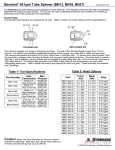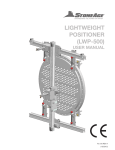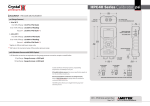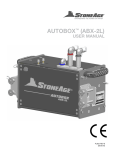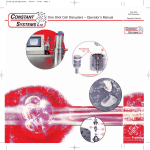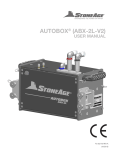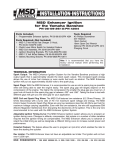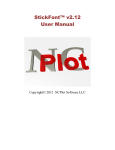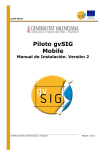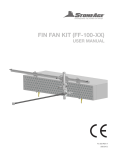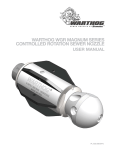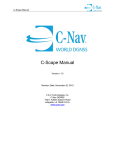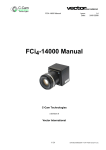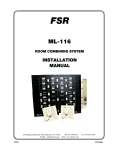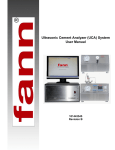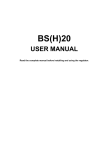Download User Manual
Transcript
Banshee® Tube Spinner (BN9.5, BN13, BN18, BN24, BN33) SAPATENTS.COM The Banshees are self-rotating swivels designed for tube cleaning. The diameter of the tool and inlet nut connection determine the model and part number. The tool can be used at operating pressures from 1000 psi to 22,000 psi, depending on the inlet connection and head jetting. Nozzle Heads: Three standard head designs are available for most sizes. Refer to Table 2 for Head Pressure and Flow Specifications. 85-105° 2X 145° 2X 135-145° 2X 90° 30° 30° 20° 15° 45° POLISHER 042 60° UNPLUGGER 043 UNIVERSAL 044 Each head is capable of a range of pressures and flows. The pull of the standard heads ranges from 3 to 5 pounds. The nozzle heads are wear items that will need to be replaced after 20 to 60 hours, depending on water filtration and operating pressure. The wrench flats provided on the Shaft, Head, Body & Nut should always be used when maintaining these tools. Table 3 details the wrench size required for each tool part. These wrenches are available from StoneAge. Table 2- Head Options Table 1- Tool Specifications Part Number Inlet Connection Max Presure BN9.5-P1 BN9.5-M7 BN9.5-MP4L BN9.5-MP4R 1/16 NPT M7-1.0 1/4-28 Left Hand 1/4-28 Right Hand 15kpsi / 1035 bar 22kpsi / 1500 bar 22kpsi / 1500 bar 22kpsi / 1500 bar BN13-P2 BN13-BSPP2 BN13-MP4L BN13-MP4R BN13-MP6L BN13-MP6R 1/8 NPT 1/8 BSPP 1/4-28 Left Hand 1/4-28 Right Hand 3/8-24 Left Hand 3/8-24 Right Hand 15kpsi / 1035 bar 18kpsi / 1250 bar 22kpsi / 1500 bar 22kpsi / 1500 bar 22kpsi / 1500 bar 22kpsi / 1500 bar BN18-P4 1/4 NPT BN18-BSPP4 1/4 BSPP BN18-MP9L 9/16-18 Left Hand BN18-MP9R 9/16-18 Right Hand BN24-P6 3/8 NPT 3/8 BSPP BN24-BSPP6 BN24-MP9L 9/16-18 Left Hand BN24-MP9R 9/16-18 Right Hand 1/2 NPT BN33-P8 BN33-BSPP8 1/2 BSPP BN33-MP9 9/16 Medium Pressure 15kpsi / 1035 bar 20kpsi / 1400 bar 22kpsi / 1500 bar 22kpsi / 1500 bar 15kpsi / 1035 bar 22kpsi / 1500 bar 22kpsi / 1500 bar 22kpsi / 1500 bar 15kpsi / 1035 bar 22kpsi / 1500 bar 22kpsi / 1500 bar Part Pressure Range (psi) Flow BN9.5-A -B 10,000 -15,000 psi 15,000 -22,000 psi 5-6 gpm 5-6 gpm BN13 - A -C 8,000 -15,000 psi 12,000 -22,000 psi 7-9 gpm 7-9 gpm BN18 - A -B -C -D 8,000 -15,000 psi 8,000 -15,000 psi 12,000 -22,000 psi 12,000 -22,000 psi 11-14 gpm 8-10 gpm 11-14 gpm 8-10 gpm BN24 - A -B -C -D -E -F 8,000 -15,000 psi 8,000 -15,000 psi 8,000 -15,000 psi 12,000 -22,000 psi 12,000 -22,000 psi 12,000 -22,000 psi 19-24 gpm 14-18 gpm 11-13 gpm 17-20 gpm 14-16 gpm 11-13 gpm BN33 - A -B -C -D -E -F -G -H -I 8,000 - 15,000 psi 8,000 - 15,000 psi 8,000 - 15,000 psi 8,000 - 15,000 psi 8,000 - 15,000 psi 12,000 - 22,000 psi 12,000 - 22,000 psi 12,000 - 22,000 psi 12,000 - 22,000 psi 39-48 gpm 32-38 gpm 25-31 gpm 19-24 gpm 14-18 gpm 21-25 gpm 17-20 gpm 14-16 gpm 11-13 gpm Caution! Never use Pipe Wrenches or Pliers to install or maintain the Banshee. After each use, always blow water out of the tool and fill with light oil such as WD-40. © 05/03/2013 StoneAge ®, All Rights Reserved Banshee® Tube Spinner (BN9.5, BN13, BN18, BN24, BN33) SAPATENTS.COM Safe Practices for Operation and Maintenance of Banshee® Tools This information is critical to ensure safe operation of the tool and to achieve maximum tool operational life. Tool life can vary based on the type and frequency of cleaning operations, but improper maintenance can significantly degrade the usable life of a tool. Most Banshee tool issues occurring within the expected reliable lifetime of the Banshee result from users not adhering to the following recommended procedures. Attention! Use the Right Tool for the Job Use a correctly sized open end wrench to fit flats provided on the Inlet Nut when attaching tool to lance. Do not use Pipe Wrench or Pliers with teeth as this can crush and/or crack the hardened steel body, leading to tool breakage in operation. Recommended torque ranges and proper wrench sizes for tightening the heads to Banshee shafts are shown in Table 3. All standard open end wrenches are available from StoneAge. Preset torque wrenches for Head installation are also available from StoneAge. Pressure Dump The pressure dump mechanism is the most important safety device when flex lancing. The operator nearest the nozzle should have control of the dump valve. If using multiple operators, each must have his own dump valve. Hose The high pressure hose should be as large as possible to minimize the pressure loss through the hose. Hose should be inspected for excessive wear or damage prior to use. The high pressure hose and end fitting should be no larger than the tool to be used on the end of it. There is an increased risk of hydraulic-ing when cleaning plugged tubes, when using larger ends. Stinger A stinger is a rigid piece of pipe or tubing used between the end of the hose and the nozzle. It is typically 2 feet in length and is primarily a safety device for hand flex lancing. When using stingers, the operator should be trained not to use it as a pry-bar or to bang on the deposit, particularly with rotating tube nozzles. They may break or stop rotating while being forced against the deposit. The coupling connecting the hose to the stinger should be of the slim-line type and no larger in diameter than the nozzle body; a larger coupling diameter increases the chances of material catching on the coupling and causing hydraulic-ing to occur. Anti-Withdrawal Device An anti-withdrawal device should be used when flex lancing. These devices provide a mechanical stop to prevent the waterjet tool from exiting the tube and injuring the operator during cleaning operations. Operation We recommend that the entire system be flushed out before installing the Banshee on the end of the hose or stinger. The swivels require a clean water supply for reliable operation; filtration of 25 micron or better is recommended. Once the system is flushed, attach the Banshee and place it in an open tube while the operating pressure is being set. When the tool is at operating pressure, the water exiting the tool through the leak paths will keep external debris from entering the tool. If the tool is not under pressure, it should not be left inside a plugged tube. Doing so could allow debris to enter and prevent rotation or cause damage to the tool. If the tool does not rotate when the dump valve is closed, the operator should try closing the dump valve slowly a few times to build up pressure slowly until normal operation is achieved. This also flushes debris out of the tool. The drilled nozzle head will last between 20 and 60 hours. Worn jets decrease the cutting rate. The tool may begin to hydraulic when cleaning plugged tubes. This occurs if the the jets are not effectively cutting the material into smaller pieces. When using rotating nozzles in plugged tubes, do not jam the head into the deposit because this will stop the rotation of the tool and impede the cutting ability. When the tool contacts the deposit, allow it to cut away the material and advance at its own rate. If it stops advancing, pull back slightly on the hose to move the head away from the deposit. This action also allows the jets to cut the deposit at different angles. The hose should be gradually fed into and out of the tube, allowing time for the jets to do their work. Repeat this process until the tube is unplugged. When polishing tubes with scale, the tool has been observed passing through a 50 foot long scaled tube in 10 seconds. While this is sufficient when cleaning easy-to-remove deposits, we recommend feeding the tool through the tube at a slower rate. This will ensure adequate cleaning. Unless the deposit is very easy to remove, this will not completely remove the scale. © 05/03/2013 StoneAge ®, All Rights Reserved Banshee® Tube Spinner (BN9.5, BN13, BN18, BN24, BN33) SAPATENTS.COM Attention! Clean and Store the Tool Properly Between jobs, the swivel should be blown out and filled with light oil. StoneAge recommends WD-40 to prevent corrosion pitting. Pitting can cause premature tool failure due to cracking. Maintenance All sizes of the Banshee tool line have a tapered shaft that fits into a tapered body. Under operating conditions these surfaces do not touch. Do not pull out on the head/shaft in order to rotate the tool, it will lock up. If this happens, tap the head/shaft on a surface to knock it free. The operators should be cautioned not to pry sideways on the tool. This may break the shaft just behind the head, particularly if a rigid stinger is being used in the inlet. Check the nozzle orifices in the head for plugging; if one becomes plugged the swivel will likely not rotate. If this does not solve the problem, the swivel should be disassembled and inspected. There are four small holes exiting the tapered portion of the shaft; these should be checked for debris and cleaned out. Blow out the body and wipe off the shaft to remove any debris. Refer to Table 3 for recommended assembly torque ranges and proper wrench sizes. Table 3- Recommended Torque Ranges and Required Wrench Sizes PART BN9.5 BN13 BN18 BN24 BN33 Shaft Head Body Nut Shaft Head Body Nut Shaft Head Body Nut Shaft Head Body Nut Shaft Head Body Nut WRENCH RECOMMENDED TORQUE RANGES (with anti-seize) SIZE (in) in-lbs ft-lbs N-m 3/16 5/16 11/32 5/16 13/64 3/8 7/16 7/16 5/16 9/16 9/16 5/8 1/2 13/16 13/16 13/16 9/16 1-1/8 1-1/8 1-1/8 36 40 3 3.3 4.1 4.5 194 216 16 18 22 24.4 63 70 5 5.8 7.1 7.9 270 300 23 25 30.5 33.9 180 200 15 16.7 20.3 22.6 540 600 45 50 61 67.8 432 480 36 40 48.8 54.2 756 840 63 70 85.4 94.9 486 540 41 45 54.9 61 1080 1200 90 100 122 135.6 BNxx 002 Inlet Nut BNxx 001 Shaft Head to Shaft torque recommendationsee Table 3 BNxx 003 Body Nut to Body torque recommendationsee Table 3 Small holes in shaft *BNxx is used to denote the BN9.5, BN13, BN18, BN24 or BN33 tools Head (see Head Options above) Warning! Use a correctly sized open end wrench to fit flats provided on the Inlet Nut when attaching tool to lance. Do not use Pipe Wrench or Pliers with teeth as this can crush and/or crack the hardened steel body, leading to tool breakage in operation. © 05/03/2013 StoneAge ®, All Rights Reserved



